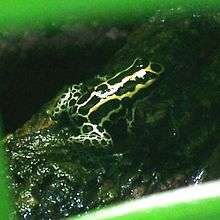Ranitomeya
| Ranitomeya | |
|---|---|
 | |
| R. ventrimaculata | |
| Scientific classification | |
| Kingdom: | Animalia |
| Phylum: | Chordata |
| Class: | Amphibia |
| Order: | Anura |
| Family: | Dendrobatidae |
| Subfamily: | Dendrobatinae |
| Genus: | Ranitomeya Bauer, 1986 |
| Diversity | |
| 16 species (see text) | |
Ranitomeya is a genus of dart poison frogs found in Panama and South America south to Peru and Brazil, possibly into Bolivia.[1]
Taxonomy
In 2006 Grant et al. revised the systematics of dart poison frogs and placed many species formerly classified in the genera Dendrobates, Minyobates and Phyllobates in Ranitomeya.[2] In 2011 Brown and colleagues, following other scientists who assumed the existence of two distinct clades in Ranitomeya, erected the genus Andinobates for 12 species of Ranitomeya.[3]
Ranitomeya and Andinobates frogs can be distinguished from those in genera such as Dendrobates in that they are generally smaller, have more than two colors, and seem to glitter if viewed from certain angles. Ranitomeya is widespread in the Amazon basin, whereas Andinobates species are found only in the northern Andes down to Central America.
Description
Adults measure no more than 21 mm (0.83 in) in snout–vent length and are typically brightly colored, often with bright yellow, red, or green dorsum that can be uniform in color or with stripes or dots. Also the throat has distinctive color, usually yellow, orange or red. Dorsal skin is smooth or weakly granular. The head is narrower than the body. Fingers and toes bear discs, with those on the fingers being large.[3]
Threats
Many Ranitomeya species are threatened by habitat loss and collection for the pet trade.[4][5][6]
Species
There are 16 Ranitomeya species:[1][7]
- Ranitomeya amazonica (Schulte, 1999)
- Ranitomeya benedicta Brown, Twomey, Pepper, and Sanchez-Rodriguez, 2008
- Ranitomeya cyanovittata Pérez-Peña, Chávez, Twomey, and Brown, 2010
- Ranitomeya defleri Twomey and Brown, 2009
- Ranitomeya fantastica (Boulenger, 1884)
- Ranitomeya flavovittata (Schulte, 1999)
- Ranitomeya imitator (Schulte, 1986)
- Ranitomeya reticulata (Boulenger, 1884)
- Ranitomeya sirensis (Aichinger, 1991)
- Ranitomeya summersi Brown, Twomey, Pepper, and Sanchez-Rodriguez, 2008
- Ranitomeya toraro Brown, Caldwell, Twomey, Melo-Sampaio, and Souza, 2011
- Ranitomeya uakarii (Brown, Schulte, and Summers, 2006)
- Ranitomeya vanzolinii (Myers, 1982)
- Ranitomeya variabilis (Zimmermann and Zimmermann, 1988)
- Ranitomeya ventrimaculata (Shreve, 1935)
- Ranitomeya yavaricola Pérez-Peña, Chávez, Twomey, and Brown, 2010
Dendrobates rubrocephalus Schulte, 1999 is placed here Incertae Sedis.[1]
References
- 1 2 3 Frost, Darrel R. (2015). "Ranitomeya Bauer, 1986". Amphibian Species of the World: an Online Reference. Version 6.0. American Museum of Natural History. Retrieved 20 April 2015.
- ↑ Grant, T., Frost, D. R., Caldwell, J. P., Gagliardo, R., Haddad, C. F. B., Kok, P. J. R., Means, D. B., Noonan, B. P., Schargel, W. E., and Wheeler, W. C. (2006). "Phylogenetic systematics of dart-poison frogs and their relatives (Amphibia: Athesphatanura: Dendrobatidae)" (PDF). Bulletin of the American Museum of Natural History. 299: 1–262. doi:10.1206/0003-0090(2006)299[1:PSODFA]2.0.CO;2.
- 1 2 Brown, J. L., E. Twomey, A. Amézquita, M. B. de Souza, J. P. Caldwell, S. Lötters, R. von May, P. R. Melo-Sampaio, D. Mejía-Vargas, P. E. Pérez-Peña, M. Pepper, E. H. Poelman, M. Sanchez-Rodriguez, and K. Summers (2011). "A taxonomic revision of the Neotropical frog genus Ranitomeya (Amphibia: Dendrobatidae)" (PDF). Zootaxa. 3083: 1–120.
- ↑ "Red list changes highlight threats from over-exploitation". TRAFFIC. 10 November 2011.
- ↑ Pepper, Mark; Brown, Jason; Twomey, Evan (15 January 2007). "Smuggling". Dendrobates.org. Retrieved 8 June 2016.
- ↑ Pepper, Mark; Twomey, Evan; Brown, Jason L. (Spring 2007). "The Smuggling Crisis" (PDF). Leaf Litter. 1 (1): 5–7. Retrieved 8 June 2016.
- ↑ "Dendrobatidae". AmphibiaWeb: Information on amphibian biology and conservation. [web application]. Berkeley, California: AmphibiaWeb. 2015. Retrieved 20 April 2015.
| Wikimedia Commons has media related to Ranitomeya. |
| Wikispecies has information related to: Ranitomeya |